Most of our publicity now takes place on social media - please follow us at @QDEC_UF, @sadieryan, @FL_VBDCoE, @aedeslady, @mundismaps, @jimomatics
2016
Grist Magazine & Climate Central: We’re starting to understand just how Zika and climate change go together
PBS Newshour: Feds approve controversial plan to release genetically modified mosquitoes to fight Zika
Living in the land of Zika raises lots of questions...
Before Hurricane Hermine hit, Governor Rick Scott came to Alachua County to explain the impact the storm might have on Zika numbers. Now an expert at UF is explaining why those numbers are continuing to rise.
Dr. Sadie Ryan is an expert at UF, who studies the effect of different climates on different mosquitos. She says the rain from the hurricane probably isn't causing a rise in Zika carrying mosquitos, because Florida regularly deals with a lot of rain. However, the debris from the storm very well could cause an increase.
Ryan says, "It wouldn't have created many more breeding sites, except where debris has fallen. I think that that's sort of the key part of this. The debris will leave more breeding sites. And they can breed in as little as half a teaspoon. So, a piece of debris that's rolled off of someone's house, or some piece of tree that's blown over that has enough of a cup to create a breeding site, that's an additional concern."
Dr. Ryan says as long as people to continue getting rid of water that builds in small cups or flower pot saucers, and other areas around their homes, the breeding should not drastically increase.
CBS4 News will keep you updated on the Zika numbers from the Florida Department of Health.
Dr. Sadie Ryan is an expert at UF, who studies the effect of different climates on different mosquitos. She says the rain from the hurricane probably isn't causing a rise in Zika carrying mosquitos, because Florida regularly deals with a lot of rain. However, the debris from the storm very well could cause an increase.
Ryan says, "It wouldn't have created many more breeding sites, except where debris has fallen. I think that that's sort of the key part of this. The debris will leave more breeding sites. And they can breed in as little as half a teaspoon. So, a piece of debris that's rolled off of someone's house, or some piece of tree that's blown over that has enough of a cup to create a breeding site, that's an additional concern."
Dr. Ryan says as long as people to continue getting rid of water that builds in small cups or flower pot saucers, and other areas around their homes, the breeding should not drastically increase.
CBS4 News will keep you updated on the Zika numbers from the Florida Department of Health.
NSF RAPID Funding to study Zika in Ecuador
The team will build on existing dengue research to explore the emergence of Zika in a hyperendemic dengue region, in 2016-2017
The team will build on existing dengue research to explore the emergence of Zika in a hyperendemic dengue region, in 2016-2017
2015
Malaria Risk in Africa shifts, grows with climate...
Our new malaria mapping study coincided with the COP in Paris, providing lots of twitter and commentary activity
SPOTS IN AFRICA COULD GET TOO HOT FOR MALARIA - Futurity.org
Our new malaria mapping study coincided with the COP in Paris, providing lots of twitter and commentary activity
SPOTS IN AFRICA COULD GET TOO HOT FOR MALARIA - Futurity.org
Researchers Consider Climate Change Impact on Public Health
Voice of America put together a nice video - our research is featured around 1.40
Voice of America put together a nice video - our research is featured around 1.40
Ryan, S.J., McNally, A., Johnson, L.R., Mordecai, E.A., Ben-Horin, T., Paaijmans, K.P., Lafferty, K.D. 2015. "Mapping physiological suitability limits of malaria in Africa under climate change" Journal of vector borne and zoonotic diseases [PDF]
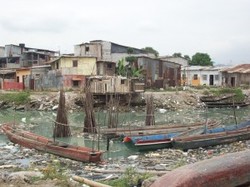
How does a mosquito in Ecuador affect people around the world?
Ryan Lab research in Ecuador was recently profiled for part of UF’s GatorGood initiative.
Ryan Lab research in Ecuador was recently profiled for part of UF’s GatorGood initiative.
New NSF EEID Grant on Climate and Vectorborne diseases
The team will tackle a suite of vectorborne diseases in a multi-institutional collaboration on theory, data analysis and novel field data collection in Ecuador, complementing ongoing dengue work.
The team will tackle a suite of vectorborne diseases in a multi-institutional collaboration on theory, data analysis and novel field data collection in Ecuador, complementing ongoing dengue work.
 Source: Wikipedia commons
Source: Wikipedia commons
COULD CLIMATE CHANGE CAUSE THE NEXT CHOLERA PANDEMIC?
MSN news describes the Looming 8th Pandemic...
Popular Science picks up on our story (link above)
Escobar, L.E., Ryan, S.J., Stewart-Ibarra, A.M., Finkelstein, J.L., King, C.A., Qiao, H., Polhemus, M.E. 2015. A Global Map of Suitability for Coastal Vibrio cholerae Under Current and Future Climate Conditions. Acta Tropica 149: 202-211 [PDF]
MSN news describes the Looming 8th Pandemic...
Popular Science picks up on our story (link above)
Escobar, L.E., Ryan, S.J., Stewart-Ibarra, A.M., Finkelstein, J.L., King, C.A., Qiao, H., Polhemus, M.E. 2015. A Global Map of Suitability for Coastal Vibrio cholerae Under Current and Future Climate Conditions. Acta Tropica 149: 202-211 [PDF]

Research findings will help in the fight against dengue
"Research findings will help in fight against dengue." ScienceDaily. ScienceDaily, 13 November 2013.
See an interview with HealthLink On Air
Stewart Ibarra’s team discovered that certain household risk factors, combined with changes in rainfall and minimum temperature, could be used to predict the presence and abundance of the mosquito that transmits dengue fever.
Stewart Ibarra, A.M., Ryan, S.J., Beltran, E. Mejía, R., Silva, M., Muñoz, A. 2013. Dengue vector dynamics (Aedes aegypti) influenced by climatic and social factors in Ecuador: implications for targeted control. PLOS ONE 8(11): e78263 [PDF]
"Research findings will help in fight against dengue." ScienceDaily. ScienceDaily, 13 November 2013.
See an interview with HealthLink On Air
Stewart Ibarra’s team discovered that certain household risk factors, combined with changes in rainfall and minimum temperature, could be used to predict the presence and abundance of the mosquito that transmits dengue fever.
Stewart Ibarra, A.M., Ryan, S.J., Beltran, E. Mejía, R., Silva, M., Muñoz, A. 2013. Dengue vector dynamics (Aedes aegypti) influenced by climatic and social factors in Ecuador: implications for targeted control. PLOS ONE 8(11): e78263 [PDF]
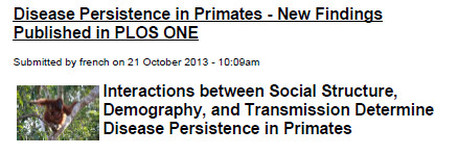
Ryan, S.J., Jones, J.H., Dobson, A.P. 2013. Interactions between social structure, demography, and transmission determine disease persistence in primates. PLOS ONE 8(10): e7686 [PDF]
Full press release here
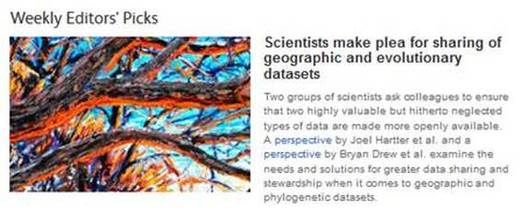
Hartter, J.*, Ryan, S.J.*, MacKenzie, C.A., Parker, J.N., Strasser, C. Spatially explicit data: stewardship and ethical challenges in science. PLOS Biology 11(9): e1001364
Joel Hartter, Sadie Ryan and collaborators comment on data stewardship and spatially explicit data in PLOS Biology. September 3, 2013.
"Disease Prevention versus Data Privacy: Using Landcover Maps to Inform Spatial Epidemic Models." PLoS Computational Biology. [Online]

When foot-and-mouth disease swept through the British countryside in early 2001, more than 10 million sheep, cattle and pigs were slaughtered to control the disease. Despite the devastation, the disease was contained within ten months in part owing to the availability in that country of finely detailed farm data, which enabled mathematical modelers to make accurate predictions about the spread of the disease and suggest optimal ways of managing it.
NIMBioS original press release: Privacy vs. Protection: Study Considers How to Manage Epidemics in Information Blackouts
On CHANS-NET
ScienceDaily
NIMBioS original press release: Privacy vs. Protection: Study Considers How to Manage Epidemics in Information Blackouts
On CHANS-NET
ScienceDaily
"Optimal temperature for malaria transmission is dramatically lower than previously predicted"
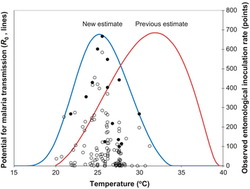
New Scientist: "Malaria study challenges warmer world predictions"
USGS: "Malaria Transmission Peaks at Much Cooler Temperatures than Previously Predicted"
U Chicago: "A Cooldown for Malaria Predictions"
Biological Posteriors (awesome name): "Building the environment into malaria models"
The Atlantic Wire: "Perfect Weather for Malaria;"
SUNY ESF: "Study Casts New Light on Malaria Transmission"
USGS: "Malaria Transmission Peaks at Much Cooler Temperatures than Previously Predicted"
U Chicago: "A Cooldown for Malaria Predictions"
Biological Posteriors (awesome name): "Building the environment into malaria models"
The Atlantic Wire: "Perfect Weather for Malaria;"
SUNY ESF: "Study Casts New Light on Malaria Transmission"
"The role of landscape connectivity in planning and implementing conservation and restoration priorities"
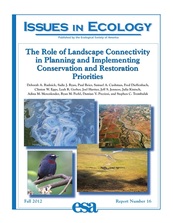
By: Rudnick, D., Ryan, S.J., Preziosi, D., Epps, C., Deiffenbach, F., Kintsch, J., Beier, P., Jenness, J., Perkl., R., Trombulak, S., Hartter, J., Gerber, L., Merenlender, A., Austen, D., Cushman, S. 2012. Issues in Ecology 16 (Fall 2012). [PDF]
CHANS-NET,
ESA: Landscape connectivity: corridors and more, in Issues in Ecology #16
PHYS.ORG: Conservation scientists look beyond greenbelts to connect wildlife sanctuaries
CHANS-NET,
ESA: Landscape connectivity: corridors and more, in Issues in Ecology #16
PHYS.ORG: Conservation scientists look beyond greenbelts to connect wildlife sanctuaries
"The utility of NDVI for predicting African buffalo forage quality"
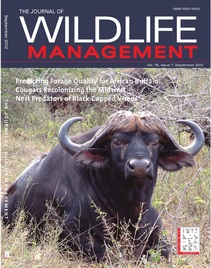
Cover article: Journal of Wildlife Management, September 2012
Ryan, S.J., Cross, P.C., Winnie, J, Jr, Hay, C., Bowers, J., Getz, W.M. 2012. The utility of NDVI for predicting African buffalo forage quality. Journal of Wildlife Management. 76(7):1499-1508 [PDF] |

Featured in "Science in Short" The Wildlife Professional, Winter 2012 Click thumbnail for larger version. |
"Consequences of Non-Intervention for Infectious Disease in African Great Apes"

S. J. Ryan and P. D. Walsh, PLOS ONE, 2011
ScienceDaily
MSNBC
Discovery News
Futurity
Santa Barbara Independent
Daily Orange - SU Newspaper
Eurekalert UCSB
SUNY-ESF
ScienceDaily
MSNBC
Discovery News
Futurity
Santa Barbara Independent
Daily Orange - SU Newspaper
Eurekalert UCSB
SUNY-ESF